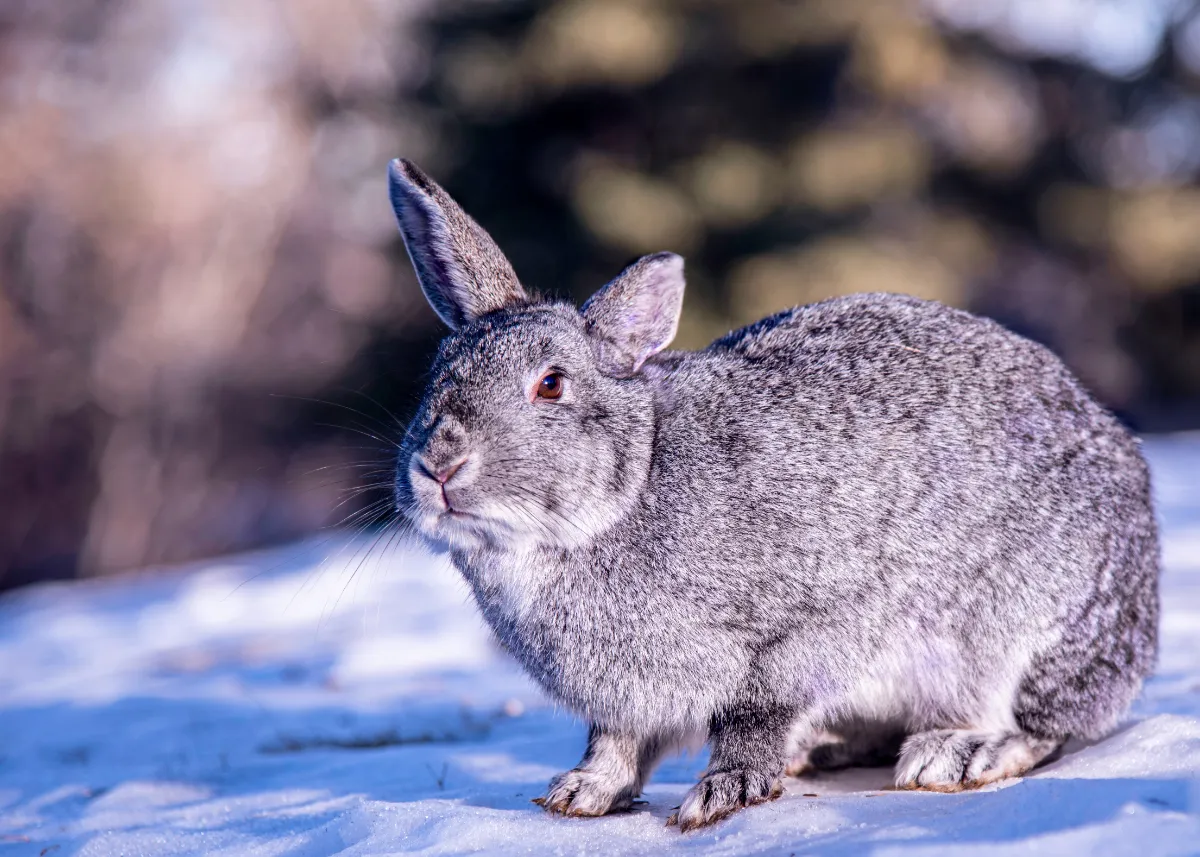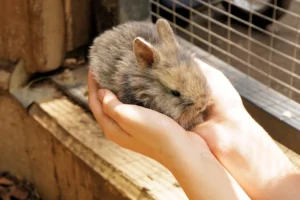Do you ever wonder how wild rabbits brave the harsh winter months? These small, furry creatures have an incredible ability to adapt and survive in the face of freezing temperatures.
In this article, we will explore the strategies that wild rabbits employ to ensure their survival during winter. From finding shelter to locating food sources, they have mastered the art of braving the cold.
So, let’s dive into the fascinating world of wild rabbit survival and discover the secrets behind their resilience.
In This Article
- 1 Key Takeaways
- 2 Finding Winter Shelter
- 3 Adapting to Cold Temperatures
- 4 Locating Food Sources
- 5 Strategies for Water Access
- 6 Maintaining Body Heat
- 7 Avoiding Predators
- 8 Reproduction and Survival Challenges
- 9 Frequently Asked Questions
- 9.1 Do Wild Rabbits Hibernate During Winter?
- 9.2 How Do Wild Rabbits Stay Warm in Freezing Temperatures?
- 9.3 Can Wild Rabbits Survive Without Access to Water During Winter?
- 9.4 What Are the Main Predators of Wild Rabbits During Winter?
- 9.5 How Do Wild Rabbits Ensure the Survival of Their Offspring in Harsh Winter Conditions?
- 10 Conclusion
Key Takeaways
- Wild rabbits construct sturdy burrows with multiple chambers for shelter and protection during winter.
- They adapt to cold temperatures by remaining active during dawn and dusk, growing thicker fur, and using thermoregulation techniques to maintain body heat.
- Wild rabbits scout for edible vegetation using their keen senses, strip the outer layers of woody plants for nutrients, and create stockpiles of food through cache storage.
- During winter, wild rabbits reproduce and nest in hidden and warm environments, providing shelter for vulnerable offspring.
Finding Winter Shelter
You should consider building a cozy burrow for winter shelter. Rabbits are small, vulnerable creatures that rely on finding safe hiding places to survive the harsh winter conditions. Construction techniques are crucial when it comes to creating a sturdy burrow.
The burrow should be dug deep into the ground, providing insulation from the freezing temperatures above. The entrance should be narrow to minimize heat loss and deter predators.
Inside the burrow, rabbits will create multiple chambers to serve different purposes. There will be a nesting chamber lined with soft materials for warmth and comfort. Adjacent to it, a food storage chamber will hold a supply of vegetation for the winter months. The burrow will also have an escape tunnel for emergency exits.
Adapting to Cold Temperatures
Bundled up in warm layers, you can brave the frigid temperatures and still enjoy outdoor activities during the winter season. While humans have various ways to adapt to the cold, animals have their own unique survival strategies. One fascinating aspect is how wild rabbits, in particular, manage to endure the harsh winter conditions. They employ two key adaptations: hibernation patterns and winter fur growth.
During the winter, wild rabbits do not hibernate like some other animals. Instead, they remain active and continue to forage for food. However, their hibernation patterns change, and they become more crepuscular, meaning they are most active during dawn and dusk when the temperatures are relatively warmer. This allows them to conserve energy and minimize their exposure to the freezing temperatures.
Additionally, wild rabbits also grow thicker fur during the winter months. This winter fur growth helps to insulate their bodies and provide much-needed warmth in the chilly weather. The longer, thicker fur traps a layer of air close to their skin, creating a natural barrier against the cold. This adaptation helps them regulate their body temperature and stay comfortable even in freezing conditions.
In conclusion, wild rabbits have fascinating adaptations to survive the winter season. By adjusting their hibernation patterns and growing thicker fur, they are able to withstand the frigid temperatures and continue their daily activities. Understanding these adaptations can help us appreciate the resilience of these incredible creatures and inspire us to protect their habitats for future generations.
| Adaptation | Hibernation Patterns | Winter Fur Growth |
|---|---|---|
| Description | Rabbits are crepuscular during winter, more active during dawn and dusk. | Rabbits grow thicker fur during winter. |
| Function | Helps conserve energy and minimize exposure to the cold. | Provides insulation and maintains body temperature. |
| Importance | Allows rabbits to survive and find food in colder conditions. | Protects rabbits from freezing temperatures. |
Locating Food Sources
The wild rabbits, with their heightened senses, are adept at locating food sources even in the harshest of winter conditions. They’ve developed a variety of foraging techniques to ensure their survival during this challenging time. Here are three strategies they employ:
- Scouting: Wild rabbits use their keen eyesight and sensitive noses to scan their surroundings for signs of edible vegetation. They carefully examine the landscape, looking for patches of grass, young shoots, and low-hanging branches that may provide sustenance.
- Browsing: During winter, when food is scarce, wild rabbits rely on their ability to nibble on bark, twigs, and buds. They use their sharp incisors to strip the outer layers of woody plants and extract the nutrients within.
- Cache Storage: To prepare for the winter months, wild rabbits engage in cache storage. They collect and hide food items in various locations, creating a stockpile for times when resources become scarce.
Strategies for Water Access
Finding sources of water is crucial for wild rabbits to survive during the winter months. In the winter, wild rabbits face a challenge when it comes to accessing water. Snowmelt dependence becomes their primary source of hydration. As the snow melts, it provides a vital water source for the rabbits.
However, this dependency on snowmelt poses risks of winter dehydration. Rabbits need to find areas where the snow has melted, exposing the ground and allowing them to access the water underneath. They may also rely on liquid water sources such as streams or ponds that remain unfrozen.
It’s essential for these water sources to be easily accessible for the rabbits to minimize their risk of dehydration during the winter months. Providing accessible water sources can greatly enhance the survival chances of wild rabbits in winter.
Maintaining Body Heat
You should layer your clothing to keep warm during the winter months. Layering helps trap air between the clothing layers, providing insulation and reducing heat loss.
Here are three thermoregulation techniques used by animals to maintain body heat:
- Shivering: Animals, including humans, shiver to generate heat through rapid muscle contractions. This helps raise the body temperature and combat cold environments.
- Countercurrent heat exchange: Many animals have adaptations that allow warm arterial blood to exchange heat with cold venous blood, minimizing heat loss. This is commonly seen in extremities like paws and ears.
- Insulation: Animals use fur, feathers, or fat to provide insulation and prevent heat loss. These adaptations help retain body heat and keep them warm during the winter months.
While some animals, like bears, may hibernate during winter, wild rabbits rely on these thermoregulation techniques to survive the cold temperatures and maintain their body heat.
Avoiding Predators
To increase your chances of survival, try staying in well-hidden areas and remaining vigilant, constantly scanning your surroundings for any signs of danger.
Wild rabbits have evolved various camouflage techniques to avoid predators. Their fur coloration often matches the surroundings, allowing them to blend in and remain undetected. Additionally, rabbits have the ability to freeze in place when they sense danger, relying on their natural camouflage to protect them.
Another survival strategy is burrow construction. Rabbits create intricate underground tunnels and chambers, providing them with safe hiding spaces to retreat to when threatened. These burrows are often well-hidden and difficult for predators to locate.
Reproduction and Survival Challenges
Don’t underestimate the reproductive abilities of wild rabbits, as they’re capable of producing multiple litters each year to overcome the survival challenges they face. These small mammals have adapted well to their environment and have developed unique breeding patterns and hibernation behavior to ensure their survival during the winter months. Here are three key aspects to consider:
- Seasonal breeding: Wild rabbits have a remarkable ability to reproduce rapidly. They typically breed from early spring to late summer, with each female capable of producing around 4-8 litters per year. This high reproductive rate allows them to quickly replenish their population.
- Nesting habits: To protect their young from harsh weather and predators, wild rabbits construct burrows or nests. These nests are carefully hidden, providing warmth and shelter for the vulnerable offspring. The females line the nests with fur and grass to create a cozy environment for their babies.
- Hibernation behavior: Unlike some other animals, wild rabbits don’t hibernate. Instead, they’ve developed strategies to survive the winter. They rely on their thick fur and fat reserves to stay warm and conserve energy during the colder months. They also have the ability to dig tunnels in the snow to find food and escape predators.
Understanding the breeding patterns and hibernation behavior of wild rabbits helps us appreciate their resilience and adaptability in the face of survival challenges. By studying these fascinating creatures, we can gain valuable insights into nature’s remarkable strategies for thriving in diverse environments.
Frequently Asked Questions
Do Wild Rabbits Hibernate During Winter?
During winter, wild rabbits do not hibernate. Instead, they create winter burrows to shelter themselves from the cold. To stay nourished, they rely on a winter diet of bark, twigs, buds, and any available vegetation.
How Do Wild Rabbits Stay Warm in Freezing Temperatures?
To stay warm in freezing temperatures, wild rabbits use a combination of insulating fur and behavioral adaptations. Their thick fur acts as a natural barrier against the cold, while they also dig burrows and group together for added warmth.
Can Wild Rabbits Survive Without Access to Water During Winter?
Wild rabbits have developed various adaptations and survival strategies to endure winter without access to water. They are able to obtain moisture from the plants they eat and have evolved to conserve water through efficient kidney function.
What Are the Main Predators of Wild Rabbits During Winter?
To survive winter, wild rabbits employ clever tactics to evade predators. They rely on their exceptional camouflage skills to blend seamlessly with their winter surroundings, making it harder for predators to spot them.
How Do Wild Rabbits Ensure the Survival of Their Offspring in Harsh Winter Conditions?
To ensure survival of their offspring in harsh winter conditions, wild rabbits use nest building techniques and food storage strategies. They construct warm and secure nests, and gather and store food in burrows to sustain themselves and their young.
Conclusion
In conclusion, wild rabbits have developed remarkable survival strategies to endure the harsh winter conditions.
From finding suitable shelters to adapting their bodies to the cold, locating food sources and water, and avoiding predators, these small creatures display impressive resilience.
However, their survival isn’t without challenges, especially when it comes to reproduction and maintaining body heat.
Understanding these strategies can help us appreciate the incredible adaptability of wild rabbits and the marvels of nature’s design.





